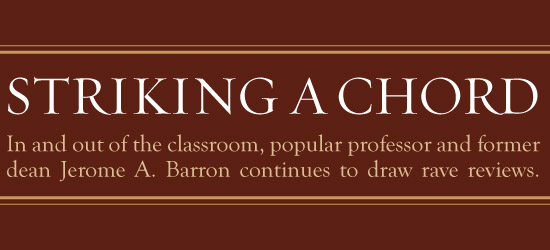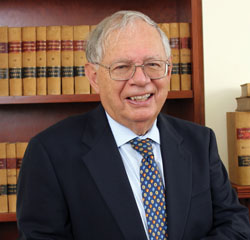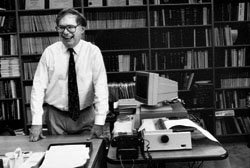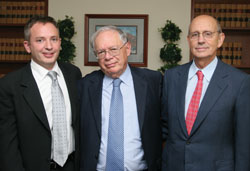
By Jamie L. Freedman
Every morning as GW Law Professor Jerome A. Barron, LLM ’60, enters Stockton Hall, the decades seem to melt away. The much-loved professor and former Law School dean, who has been a fixture on campus since 1965, has enjoyed a rich and rewarding career at GW Law. Now, 40 years after penning the groundbreaking Harvard Law Review article “Access to the Press—A New First Amendment Right,” the renowned constitutional and media law expert’s arguments about media access are attracting renewed attention in the national legal community.

|

Claire Duggan
|
In January, Hofstra Law School in New York, in conjunction with the Brennan Center at New York University, hosted a well-attended conference to mark the occasion titled “Reclaiming the First Amendment: Constitutional Theories of Media Reform.” GW followed suit with a two-day symposium Oct. 11 and 12, “Access to the Media—1967 to 2007 and Beyond,” featuring opening remarks by U.S. Supreme Court Justice Stephen G. Breyer. A sequence of lively panel discussions followed, bringing together prominent legal scholars from across the nation who skillfully debated related themes, updating
Barron’s 1967 arguments to today’s Internet-connected world, with its proliferation of media.
Barron, who wrote the landmark piece during the early years of his tenure at GW, says that he’s delighted that his paper is still “striking a chord.” In a nutshell, the article disputed the romantic notion of a free and accessible marketplace of ideas in the press. On the contrary, Barron argued that concentrated corporate ownership dominated the mass media—effectively censoring free speech and quelling unorthodox ideas. “If ever there were a self-operating marketplace of ideas, it has long ceased to exist,” he wrote.
In the article, he ambitiously called for a reinterpretation of the First Amendment to impose an “affirmative responsibility” on media owners to publicize a diversity of viewpoints and promote free debate. “The First Amendment objective of a free flow of political information and ideas vital to a functioning democracy was being undermined,” explains Barron, whose seminal work argued for a “judicial remedy affording individuals and groups desiring to voice views on public issues a right of nondiscriminatory access.”
From his comfortable office on the fourth floor of Stockton Hall, Barron says that the symposium brings his career full circle. “I am truly touched and delighted that this law school where I spent my life has honored my work on media access in this very meaningful way,” says Barron, GW’s Harold H. Greene Professor of Law.

In the early days of his tenure at GW Law, Barron enjoys a moment in his then-office on the 5th floor of the Burns Law Library Building.
|

|
The popular professor says that he originally planned to practice law in his native Massachusetts but changed his mind once he got a taste of GW Law. “The most fortuitous things in life are often the most important, and I came to GW fortuitously but happily,” Barron says. He was working for a small law firm in Boston in 1959 after graduating from Yale Law School when his close friend, Sanford Katz (now professor of law at Boston College Law School), who was clerking in Washington, called him with a tip. “He told me that there was a last-minute opening for a teaching fellow at GW Law and encouraged me to apply.”
Barron was interviewed by Acting Dean Lou Mayo, an authority on the regulation of broadcasting, who had been appointed by the Federal Communications Commission to conduct a network study report. “In those days, the three major networks were the dominant media—like the Internet is today, since most of the country sat down every night to watch the evening news,” Barron explains. Mayo hired him and encouraged Barron to simultaneously teach and pursue an LLM at GW.
Barron was quickly smitten with academia—and with communications law. “Lou Mayo was interested in the public responsibility of broadcasters, and I took a wonderful course of his on public policy and mass media focusing on the FCC’s Fairness Doctrine,” he reflects. Barron became fascinated by the doctrine, which required broadcasters to provide an overall balanced presentation of ideas. “That was a very interesting idea to me, which became the subject of my LLM thesis,” he says.
Before settling permanently at GW Law, Barron clerked for a year for Marvin Jones, the chief judge of the U.S. Court of Claims, worked for a Washington law firm, and taught at the University of North Dakota Law School. “There were only 160 students in the entire school,” notes Barron, who signed on for a two-year stint in North Dakota in 1962. “It was a great adventure, as I had never been west of the Mississippi River!”
Barron’s next stop was the University of New Mexico, where he spent a year as a visiting professor before receiving an invitation from Bob Kramer, then dean of GW Law School, to return to Washington as a member of his full-time faculty.
What’s kept Barron here all these years? “GW is a wonderful and exciting place to be,” he says. “I’ve had so many opportunities here and have always enjoyed the students, who come from all over the country and the world and are interested in many of the same things that I am. It’s the kind of job that I’d be happy to do even if they didn’t pay me!”

|

Professor Jerome A. Barron poses with son David Barron and U.S. Supreme Court Justice Stephen G. Breyer at the October GW Law Review event commemorating Barron’s 1967 article “Access to the Press—A New First Amendment Right.” Breyer delivered remarks during the event’s opening. David Barron, a professor at Harvard Law School, spoke at the event’s luncheon.
Abdul El-Tayef/WPPI.com
|
As a professor, Barron has drawn rave reviews from his GW Law students. Over the decades, he has taught a variety of courses, ranging from civil procedure and federal courts to constitutional law and First Amendment law. Barron encourages his students to stretch their minds: “At the beginning of every constitutional law course, I used to tell my students that if the class was successful, those who were conservative ought to come away a little more liberal, and those who were liberal ought to come away a bit more conservative.”
Barron makes a lasting impression on many of his students, says GW Law School Dean Frederick M. Lawrence, who calls Barron his “friend, colleague, and mentor.” “When alumni from decades past visit the Law School, it’s remarkable how often their favorite GW memories involve Jerry Barron,” he says. “He’s an extraordinary teacher with tremendous enthusiasm and love for his subject matter, and he lets his students know that there’s nothing else that he’d rather be doing than teaching them. All these years later, you can still see it in their eyes when they talk about him.”
Through the years, Barron says he has had the good fortune to work with stimulating faculty colleagues, many of whom have become his good friends. “Each faculty constellation has its own interesting dynamic, so the job never gets old,” he says. “We’ve had a number of wonderful professors through the years who have really changed the disciplines they were working in. That’s very exciting to me, and I suppose in some ways it prompted me to do the same.”
Many of Barron’s fondest GW Law memories center on his years as dean. “It was a real highlight of my life,” says Barron, who was at the Law School’s helm from 1979 to 1988. As dean, with the support of President Lloyd Elliott, he presided over a major expansion of the Law School’s physical plant—erecting Lerner Hall, renovating Stockton Hall, and substantially expanding the Burns Law Library.
“One of my primary missions as dean was to improve GW’s physical plant,” he says. “I’m proud that for the first time, we began to have the kinds of physical facilities that our reputation and our importance in the law school world had long demanded. Of course, my successors have greatly expanded the facilities of the Law School far beyond those beginnings, but I do think that under my deanship it got started.”
During Barron’s tenure as dean, Lyle and Frieda Alverson passed away and left the Law School $7.5 million, which Barron allocated to new faculty positions. “I thought that one of our problems historically was an unsatisfactory student-faculty ratio, and I saw the Alverson gift as an opportunity to address that,” he explains. “As a result of the gift, we created three new chairs and four faculty positions, greatly expanding our faculty. When I became dean, we had 35 to 40 faculty members, and today we have around 90, so we’ve come a long way.”
The toughest issue that Barron had to tackle as dean was the emotionally charged night school controversy. “The night school was suffering declining enrollment and a shrinking pool of applicants, so the faculty and I considered discontinuing it,” Barron reflects. “Through the wonderful assistance of Glen Wilkinson [JD ’38] who was chairman of the board of trustees at the time, the controversy was mediated to everyone’s satisfaction, but it certainly was contentious during its time. Thankfully, the night school is thriving now and certainly doesn’t lack for students.”
As much as he enjoyed his decade as dean, Barron advises that it’s important to know when to pass the gavel. “No dean should stay forever, because when you first take over, you clearly see what needs to be done, but after you’ve been in the job for awhile, it’s sometimes hard to see what’s broken,” he says. “We’ve been very lucky at GW to have some wonderful deans who have contributed a great deal through the years and helped to make the Law School such a special place.”
He has taken full advantage of GW Law’s location in the heart of the nation’s capital, arguing and participating in First Amendment cases before the U.S. Supreme Court and serving as a consultant to the Senate-convened Watergate committee. “Being here gives you a lot of opportunities,” Barron says.
A special highlight for him was defending a state right-of-reply statute before the Supreme Court in Miami Herald Publishing Co. v. Tornillo. The 1974 case involved Pat Tornillo, head of the classroom teachers union in Dade County, Fla., who led a strike for better wages despite a state law prohibiting strikes by public school teachers. “Some time later, he ran for the legislature in Dade County, and the Miami Herald, which then as now was the largest circulation newspaper in Florida, opposed his candidacy and wrote a couple of editorials that were extremely critical of him, including one called ‘So Lawbreakers want to be Lawmakers,’” Barron recalls. The case attempted to strike down Florida’s right-of-reply law providing equal space to political candidates responding to personal attacks. Arguing the case on behalf of Tornillo, Barron fought to establish access to the media as a First Amendment right.
“We basically argued that a right of reply implemented debate and that free debate was what the First Amendment was all about,” he explains. Tornillo won in the Supreme Court of Florida but lost in the U.S. Supreme Court. “The court was very sympathetic to our arguments for access to the media and expressed concern about the growing concentration of ownership in the media in the United States, which is worse today than it was then,” comments Barron. “But, in the end, they thought it would interfere too much with the editorial function and inhibit newspapers from taking strong positions if they had to put the other side on.”
At around the same time, Barron was invited by his good friend and GW Law colleague Arthur S. Miller—then chief consultant to the Senate Watergate committee—to serve as a consultant to the committee. “I was involved in the pleadings, complaints, and court proceedings that the Watergate committee brought against President Nixon in order to obtain the tapes,” he states. “It was marvelously exciting. One of the great things for a law professor is to participate in important events like these that involve not only your field but the nation.”
On the national stage, Barron has also been an active leader in professional organizations, serving as chair of the ABA Committee on Graduate Legal Education and the AALS Section of Mass Communication Law. In 2004, he served as the Fulbright Distinguished Chair in Law at the University of Trento —located in northeast Italy.
A prolific writer, Barron has produced and edited numerous articles and books, including constitutional law and communications law casebooks. He is the author of Freedom of the Press for Whom? (1973) and Public Rights and the Private Press (1981).With his GW Law colleague and friend C. Thomas Dienes, Barron co-authored Constitutional Law: Principles and Policy (7th ed., 2006), Constitutional Law in a Nutshell (5th ed., 2003), First Amendment Law in a Nutshell (3rd ed., 2005), and Constitutional Law: Black Letter Series (7th ed., 2004).
On the home front, Barron has been married for 46 years to Myra, a retired attorney. Two of their three children have followed in their footsteps as lawyers. “Our son David (who introduced his father at the symposium lunch) is a law professor at Harvard, and our daughter, Jennifer, is a lawyer and GW alum (JD ’95) who lives in Naperville, Ill.,” he says. “Our older son, Jonathan, is a professor of English at the University of Southern Mississippi, specializing in 20th-century American poetry. We say that he is our contribution to civilization!” In their spare time, the couple enjoys traveling to visit their growing family (which includes seven grandchildren), visiting art galleries, and collecting art “in a modest way.”
Barron says that he can’t believe nearly half a century has gone by since that auspicious day in 1959 when he walked up the steps of Stockton for the first time. “I can still envision it as if it were yesterday,” he exclaims. “It’s all been one wonderful day.”
|